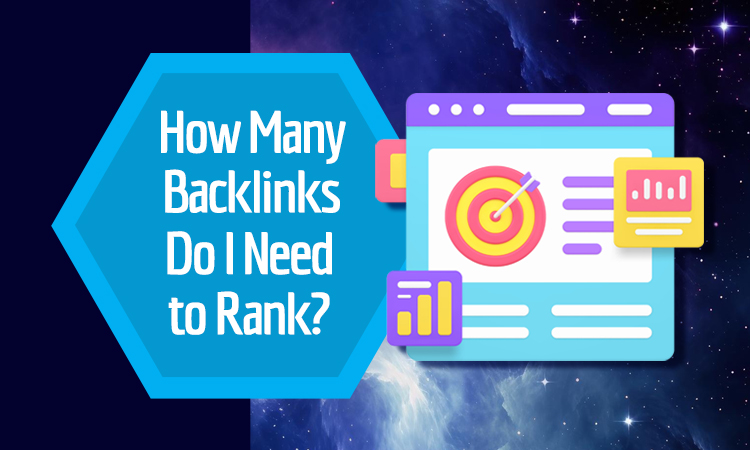Wondering How Many Links You Need to Rank?
Determining how many backlinks you need can be nuanced, as your niche, competition, and the strength of your existing online presence influence it.
You can determine how many links you need using the following process and find your answer to the age-old question of “How many backlinks do I need to rank”?
Click here for additional context about the sites and processes covered in the video, including the specific link counts
Key Takeaways
- Relevant links, especially from high-quality, authoritative sources, are crucial for SEO, but there’s no set number needed for ranking as it varies by niche and competition.
- Analyzing competitor backlink profiles with tools like Ahrefs and Moz can provide valuable insights into enhancing your link-building strategy and staying competitive.
- Creating high-quality, audience-centric content is the bedrock for attracting organic backlinks, and a robust internal linking strategy improves SEO by effectively guiding site visitors and search crawlers.
6 Simple Steps To Determine How Many Links You Need
If you’re looking to establish how many backlinks you need to compete effectively for a given keyword, follow these straightforward steps:
- Identify Your Competitors: Search for your target keyword on Google and list the top-ranking websites.
- Use a Backlink Analysis Tool: Tools like Ahrefs or Moz can provide data on your competitors’ backlinks. Enter the URLs of the competitor websites into the tool.
- Calculate Average Backlinks: Look at each competitor’s number of unique referring domains and calculate the average. This gives you a baseline for the number of links the top sites get.
- Analyze Backlink Quality: Don’t just focus on quantity. Assess the quality of backlinks your competitors have. Look for the authority of linking domains, relevance, and the follow vs. no-follow ratio. If you aren’t doing local SEO, ignore any sites with a DR below 20 in your count.
- Set Your Target: Based on your competitors’ average number and quality of links, set a realistic target for your website. Aim for a mix of quality and quantity that matches or exceeds the average.
- Develop Your Strategy: Plan your link-building strategy to meet your target. This could include creating high-quality content, reaching out for guest posts, or engaging in broken link building. Use what you find when analyzing competitor link profiles to guide you toward the most effective tactics.
By following these steps, you can get a clear idea of the number of backlinks you need to aim for and create a focused strategy to achieve your SEO goals.
The Long Version: Determining How Many High-Quality Backlinks You Need
Here’s an in-depth overview for those who prefer the nitty gritty details.
{If you are reading between the lines, all the words below this point are here to appease G**gle. The video and text above answer “how many backlinks do I need to rank” in fewer words.
Since we don’t have as much expertise on this topic as 5-year-old Reddit and Quora posts (you know what I’m saying), we must use more words to answer a fairly straightforward question.
It is also worth noting that throughout this article, we use backlinks and links interchangeably due to the optimization requirements for this article. What we mean when we say backlinks is the number of unique referring domains, not how many backlinks you get.}
Anyway, back to it. Read on to find out how many backlinks you need.
The Backlink Benchmark: Understanding the Essentials
When embarking on your SEO journey, the first crucial point to comprehend is the terrain of the backlink landscape. Like stars guiding sailors, backlinks help search engines discover and value your website.
But as you chart your course, you’ll find no universal sextant to measure the exact number needed to rank effectively. Your niche’s competitive waters might require a fleet of backlinks or a select armada to outmaneuver rivals and capture the coveted top positions.
So, rather than an arbitrary tally, what’s paramount is a strategic approach to building backlinks that considers your unique industry seascape.
The Role of Backlinks in Modern SEO
Backlinks are the propelling force in your SEO journey, acting as indicators to search engines of your content’s value and authority.
These endorsements, particularly high-quality backlinks, are the currency of the digital realm, increasing traffic and revenue and confirming their enduring relevance in SEO strategies today.
Quality trumps quantity, and pursuing organic backlinks from reputable sources takes precedence over the mere number of backlinks.
Competitive industries may call for a more extensive collection of these high-quality links, so quality without the property quantity isn’t nearly as effective.
Assessing Backlink Quality: What Counts?
While striving for superior rankings, it’s crucial to understand that not all backlinks hold the same value.
The most prized are those with high source authority and trustworthiness, earned through the merit of your content’s quality—these are the jewels of your backlink crown.
Like spices from the Orient, relevance and a diverse range of authoritative domains spice up your backlink profile, signaling your content’s worth to search engines and broadening its appeal.
Do-follow backlinks usually contribute most to your rankings, though a high-quality no-follow link can still boost your brand’s perception. To assess a backlink’s actual value, consider its source quality, use of relevant anchor texts, and the authority of the linking site.
Quantity vs. Significance: Striking the Right Balance
Regarding backlinks, the key is to balance both the quantity and the quality of these digital endorsements.
While the siren song of acquiring too many backlinks is tempting, remember that not all confer the same value, and some can even be detrimental. This highlights the need for a strategic and balanced approach.
So, you might wonder how many backlinks are ideal for your website and how many links you should focus on for optimal results.
To evaluate your backlink strategy’s impact, analyze metrics such as the total backlink count, domain diversity, anchor text distribution, and the balance of followed versus no-followed links.
Decoding Your Competitors’ Backlink Profiles
While navigating the SEO landscape, it’s advantageous to scrutinize your competitors’ backlink strategies.
Understanding their arsenal reveals the number of backlinks you might need to stay competitive. By studying the strategies and patterns of successful websites, you’ll uncover insights that can steer your link-building efforts.
Knowing the average backlink count of top-ranking sites offers a benchmark, suggesting how many you might need to reach the search results’ promised land.
As you will certainly uncover in your analysis, some keywords and niches require fewer backlinks.
Tools for Competitive Backlink Analysis
To map out your competitors’ backlink profiles, you can utilize tools such as Ahrefs and Moz, which significantly ease this task.
Features like Ahrefs’ Link Intersect report highlight uncharted linking opportunities and competitor tactics.
Filters in these tools allow you to refine data, like showcasing backlinks from English pages with traffic—essentially highlighting the trade routes of the digital sea.
These SEO tools are like telescopes, extending your sight across the horizon to compare backlink profiles and gain strategic insights.
They offer functionalities like backlink analysis, anchor text insights, and domain authority metrics, vital for identifying lost backlinks and plotting your course.
Learning from Top Performers
For successful backlink navigation, it’s imperative to glean insights from the top performers.
A competitor backlink analysis reveals the allies linking to top-ranking pages for your target keywords, potentially uncovering new ports for your link-building voyage.
Common backlinks between competitors can signal patterns and high-traffic domains that may also extend a hand of friendship to your site.
Such analysis might reveal unique sources like interviews and podcast links, paving the way for similar media engagement opportunities.
Building a Strong Foundation: High-Quality Content Creation
The success of your SEO journey is fundamentally anchored in creating high-quality content.
It’s the treasure that lures organic backlinks to your shores, with business websites boasting blogs attracting more backlinks than those without.
Content that addresses common problems or answers your audience’s burning questions becomes a beacon, shining brightly enough to be seen—and linked to—from afar.
By categorizing your content to resonate with the right websites, you enhance the likelihood of gaining natural backlinks.
Implementing topic clusters can create a network of interlinked content pieces, reinforcing your site’s content architecture and SEO footing.
Strategies for Producing High-Quality Content
Your content must be compelling, akin to the ‘Skyscraper’ method, or you can leverage other content types, like statistics posts, to effectively draw organic backlinks.
Provide value at the top of the funnel without being overly promotional to compel other sites to link to your pages.
Showcasing expertise and answering readers’ needs fortifies your backlink strategy as it encourages websites to share and link to your content.
A successful blog is a tapestry of content forms woven with long-form articles, keywords, images, videos, and infographics, all beckoning backlinks to dock at your site.
Aligning Content With Target Audience Needs
For your content to effectively attract backlinks, it should resonate with the interests and needs of your target audience.
Resource pages that compile valuable information become treasure chests, earning more backlinks by appealing directly to your audience’s quests for knowledge.
Identifying organic backlink opportunities involves reaching out to websites your target audience frequents and offering content that adds value to their journey.
Pillar pages, targeting your target keyword and broad keywords with high search volumes, organize your content effectively and attract more backlinks like a bustling port attracts ships from across the seas. While these are on-page SEO tasks, they will tremendously impact the effectiveness of your outreach link building.
Crafting a Robust Backlink Strategy
A robust backlink strategy is essential for a triumphant journey in the SEO landscape.
Building high-quality backlinks from reputable sources establishes your site’s credibility and drives meaningful traffic like a well-known flag signaling safe harbor.
Steer clear of spammy backwaters, as backlinks from such sources can tarnish your reputation and sink your rankings. Link-building packages are also best avoided.
Your link-building efforts should be part of a holistic SEO strategy, prioritizing high-quality backlinks that will likely bring in real, targeted visitors.
Similar to sending envoys to foreign lands, personal outreach is crucial to securing valuable links and forming lasting alliances.
Identifying Opportunities for Organic Backlinks
Searching for organic backlink opportunities is similar to exploring new territories.
Here are some strategies to consider:
- Check backlinks reports for listicles mentioning competitors to find potential inclusions for your backlinks.
- Engage in community forums and discussion boards relevant to your niche to showcase your expertise and content, which can lead to natural backlink opportunities.
- Collaborate with influencers and bloggers in your industry to share your content or create co-branded content, which can result in high-quality backlinks.
- Participate in industry webinars or virtual conferences and contribute valuable insights, which can be shared with your website link, expanding your backlink profile.
A list of relevant websites frequented by your target audience can lead to beneficial backlink opportunities.
Broken link building is like salvaging sunken ships, finding and suggesting replacements for dead links on other websites with content from your page, which not only earns backlinks but also forges new relationships.
Outreach strategies, such as well-crafted emails to website owners, facilitate this process.
Leveraging Guest Posts and Editorial Outreach
Guest posting and editorial outreach are potent tools in your SEO toolkit. They help you earn respect and backlinks, much like emissaries sent to distant lands.
By contributing unique and valuable content to reputable blogs within your niche, you can construct a reputation as an authority and unlock new backlink channels. Observing the link-building tactics of competitors, like guest posts, can inform and refine your link acquisition strategy.
Discovering competitors’ guest posts by searching for their marketers’ names in content explorer tools can reveal platforms open to guest contributions, providing a map to potential allies.
Analyzing the anchor text and target URLs in backlink reports offers a glimpse into how competitors are mentioned in the content, which can inspire your guest posting strategy.
Refining Internal Links for SEO Success
Your website’s internal linking structure serves as the rigging that holds your sails.
This network guides visitors and distributes page authority, acting as the trade winds that propel your SEO journey.
Strategic placement of internal links with descriptive anchor text can establish relevance and improve rankings for those keywords, just as a well-marked map leads to treasure.
However, internal links should not be haphazard; they must make contextual sense and add value to the user’s experience, much like a knowledgeable guide on a treacherous trail.
Ensuring your internal link structure is crawler-friendly is critical, as search engines depend on these links to discover new content on your website.
Optimizing Internal Link Structure
When optimizing your website’s internal link structure, consider it as arranging a fleet into a strong formation.
The hub and spoke model effectively arranges your content, with hubs acting as main category pages and spokes as detailed subcategories, enhancing topical authority and user experience.
Strategic placement of internal links on related content pages can elevate the rank of crucial pages, acting as a ranking factor, just as a flagship leads a fleet.
Enhancing User Experience with Internal Links
Enhancing user experience with internal links is crucial, as a smooth voyage encourages more prolonged engagement.
A well-planned internal link structure is like a map filled with exciting landmarks. It makes it easier for visitors to navigate and find relevant pages, leading to longer visit durations.
Keeping your site’s content interconnected with regular updates to older pages with new internal links ensures relevance, offering users paths to discover more content.
Technical SEO: Ensuring Search Engine Crawlers See the Value
In the SEO realm, technical prowess is as important as a ship’s readiness for the sea. Ensuring that search engine crawlers can see your site’s value is akin to ensuring that your lighthouse is visible from the sea.
Addressing crawlability and indexability issues, such as broken links, is vital for maintaining your site’s health and visibility and preventing your rankings from being marooned.
Making Your Site Crawler-Friendly
To make your site as welcoming as a bustling port for search engine crawlers, manage crawler directives carefully, submit updated sitemaps frequently, and use noindex and nofollow tags wisely.
Implementing on-page SEO techniques will also contribute to this goal.
Ensuring your digital docks are free from 4xx errors and unnecessary redirects helps improve your site’s ability to welcome visitors and crawlers.
Quality internal linking can vastly improve the number of pages indexed by search engines, leading to better visibility, just as a well-connected port facilitates trade.
Varying anchor text for internal links with descriptive terms also enhances context for search engine understanding.
Addressing Broken Links and Redirects
A ship in good repair sails smoothly, as does a website with no broken links.
Using SEO tools to identify and mend these digital fractures helps preserve the link equity crucial for SEO performance.
Fixing broken links not only maintains the integrity of your site but also ensures that the flow of traffic and search engine crawlers is unimpeded.
When correction isn’t possible, setting up proper redirects is like building detours that guide users and preserve the value of old routes.
Measuring Your Progress with SEO Metrics
While exploring the vast expanse of SEO, it’s essential to gauge the prevailing trends to ensure you’re making the right decisions.
In the context of backlinks, this means keeping a close eye on specific Key Performance Indicators (KPIs) that reflect the health of your backlink strategy and the overall performance of your SEO efforts.
Some important KPIs to monitor include:
- Number of referring domains
- Anchor text diversity
- Link quality and relevance
- Organic search traffic
- Rankings for target keywords
By regularly monitoring these KPIs, you can identify areas for improvement and make informed decisions to optimize your backlink strategy.
These metrics are the compass that guides your adjustments and the sextant that confirms your position in the search engine rankings.
Using Google Analytics and Search Console for Insights
Google Analytics and Search Console are vital tools, providing valuable insights into referral traffic, keyword rankings, and user engagement based on backlink sources.
In Google Analytics 4, the Traffic Acquisition report offers a detailed analysis of referral traffic, allowing you to see which backlinks bring in the most valuable visitors.
Google Search Console complements these insights, showing the top linking websites and offering a clear view of your domain’s top linked and linking pages.
Discover Your Ideal Backlink Strategy
Each website’s quest for the perfect backlink count is unique.
We’ve charted a course through the crucial role of backlinks in SEO, the art of quality assessment, and the tailored approach needed for strategic link building.
By delving into competitor analysis and anchoring your efforts in premium content, you’ve prepared to navigate the SEO waters.
We’ve equipped you with the knowledge to precisely refine your link and technical SEO strategies and measure success.
Ready to set sail on a backlink voyage that delivers tangible results and a strong ROI? Contact Stellar SEO to craft your custom strategy and build a campaign that charts a course to success.
















